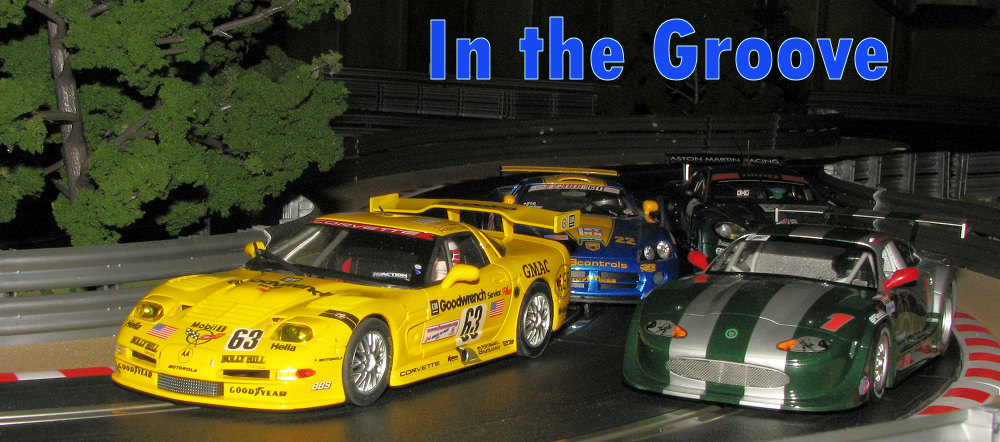

Adding scenery is an on-going thing and I've found that I can do a bit here and do a bit there as time permits. All I need are the materials and a few minutes time. But there is more to a slot car track than adding in trees and weeds.
For most of us, it is the cars that make the hobby fun. Today's slot cars are as much scale models as what we like to build for static display. Except these move and so so rather quickly in most cases. There are a huge number of companies that produce slot cars and an equally large number of cars and power train layouts.
One thing I have noticed is that the majority of these cars are manufactured in either Spain or China. Guess we cannot get away from the fact that China is the new manufacturing powerhouse. Regardless, they do produce some superb replicas, so let's take a look at some of the items that are out there.
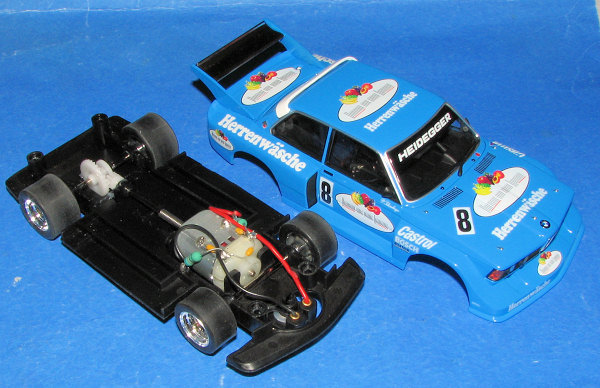 Revell is a well known name and
both they and Monogram were in on the ground floor of the hobby in the mid
1960s. One of their more recent issues is a series of BMW 320i cars. This was
chosen due to the many liveries that were worn during the German BMW racing
series. Several of these cars also participated in the Camel GT championship in
the early 1980s in the US. This latest Revell car is a blue Fruit of the Loom
sponsored car, but apparently Revell did not want to pay a royalty so the name
has been left from the body!
Revell is a well known name and
both they and Monogram were in on the ground floor of the hobby in the mid
1960s. One of their more recent issues is a series of BMW 320i cars. This was
chosen due to the many liveries that were worn during the German BMW racing
series. Several of these cars also participated in the Camel GT championship in
the early 1980s in the US. This latest Revell car is a blue Fruit of the Loom
sponsored car, but apparently Revell did not want to pay a royalty so the name
has been left from the body!
The slot car itself has a front
motor, extension shaft and rear drive. It is relatively fast as these cars go
and had very good magnetic traction. It also drives quite differently from some
other motor mounting arrangements. The image to the left shows the detail
in the body and also the chassis. You can see that the tires are not square on
the wheel as most of the areas rubbed down are on the edges. Most racers will
run the tire against sandpaper until the wear area is all across the tire
itself. My preference is to replace the rear tires with a silicone based tire
that provides superior traction to the rubber one provided in the kit. However,
I have not been able to find one for this particular car. The mot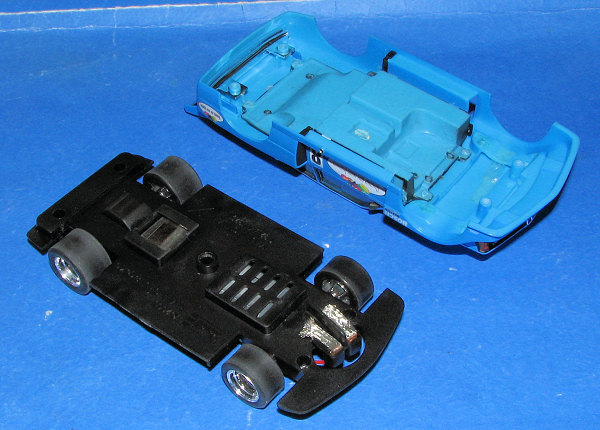 or
you see in this car is also pretty much of a standard design that is used by
many other companies. It operates at about 18,000 - 20,000 rpm maximum and has
enough torque to overcome the magnetic attraction. As you see in the other
image, of the underside of the car chassis, there is a small square area near
the back. This houses the magnet and allows the magnet to be moved a bit forward
or back. This will affect the traction somewhat, though due to the limited
motion, there is not that much difference. As you see in the front, there are
two braids that pick up the DC current from the track strips. My Scalextric
power packs will provide a bit less than 14 VDC. The slots in the front are for
cooling as these motors can get quite warm if operated for a period of time,
especially if the car has strong magnetic attraction. You an also see that the
body has a somewhat complete interior and there are four mounting posts. As I
mentioned, this is a nice car and runs quite well even right out of the box.
Retail price for cars like this are in the $40-$50 range, so inexpensive they
are not. However, these cars come ready to run and as I mentioned, they run
great right from the box.
or
you see in this car is also pretty much of a standard design that is used by
many other companies. It operates at about 18,000 - 20,000 rpm maximum and has
enough torque to overcome the magnetic attraction. As you see in the other
image, of the underside of the car chassis, there is a small square area near
the back. This houses the magnet and allows the magnet to be moved a bit forward
or back. This will affect the traction somewhat, though due to the limited
motion, there is not that much difference. As you see in the front, there are
two braids that pick up the DC current from the track strips. My Scalextric
power packs will provide a bit less than 14 VDC. The slots in the front are for
cooling as these motors can get quite warm if operated for a period of time,
especially if the car has strong magnetic attraction. You an also see that the
body has a somewhat complete interior and there are four mounting posts. As I
mentioned, this is a nice car and runs quite well even right out of the box.
Retail price for cars like this are in the $40-$50 range, so inexpensive they
are not. However, these cars come ready to run and as I mentioned, they run
great right from the box.
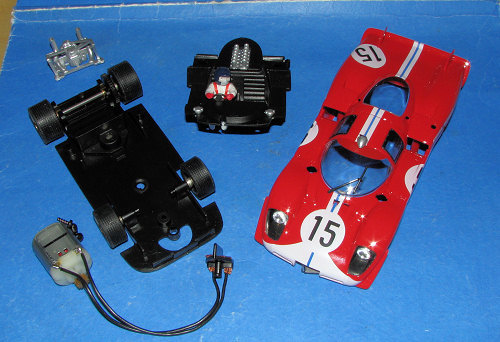 Not all slot cars are ready to
run types. There are a few that are kits. Fly is one company that produces cars
as kits. Now these are not the same sort of thing as you might think as they are
mostly already assembled into sub assemblies. However, they do save some money
along the way as these retail for $35 and offer several different cars. The
liveries on these kits are different from any of the 'normal' RTR cars that Fly
offer. This particular one is a Ferrari 512S 'long tail' as run in Le Mans and
at Daytona and other high speed circuits. They are also generally not well QA'd.
The major parts of this car are shown to the left. As you can see, you get a
complete chassis (I installed the rear motor cradle assembly for the photo; it
just slots in place), a motor with the pickup already wired, a body, interior
and the other bit fits to the back as a transmission/exhaust piece. You can see
that the central light has been knocked out of this car during shipping. A
Porsche 917 kit I bought from this company was completely missing the headlight
assembly, but an e-mail to the place where I bought it soon brought a
replacement.
Not all slot cars are ready to
run types. There are a few that are kits. Fly is one company that produces cars
as kits. Now these are not the same sort of thing as you might think as they are
mostly already assembled into sub assemblies. However, they do save some money
along the way as these retail for $35 and offer several different cars. The
liveries on these kits are different from any of the 'normal' RTR cars that Fly
offer. This particular one is a Ferrari 512S 'long tail' as run in Le Mans and
at Daytona and other high speed circuits. They are also generally not well QA'd.
The major parts of this car are shown to the left. As you can see, you get a
complete chassis (I installed the rear motor cradle assembly for the photo; it
just slots in place), a motor with the pickup already wired, a body, interior
and the other bit fits to the back as a transmission/exhaust piece. You can see
that the central light has been knocked out of this car during shipping. A
Porsche 917 kit I bought from this company was completely missing the headlight
assembly, but an e-mail to the place where I bought it soon brought a
replacement.
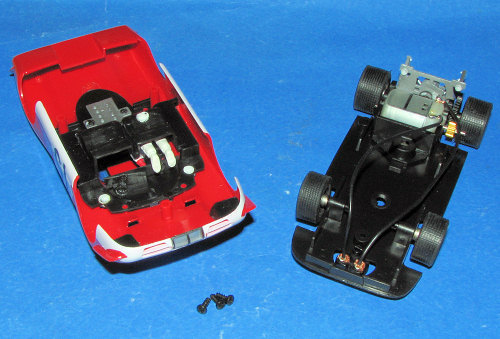 OK, so I have all the parts.
First thing I did was to get the interior to fit into the body. On this kit, it
was quite easy. On the Corvette in the opening shot, also a Fly kit car, but
with a front motor, it was a real pain in the butt to get the interior in place.
it just didn't want to fit and I struggled with it for a long time before it
finally succumbed.
OK, so I have all the parts.
First thing I did was to get the interior to fit into the body. On this kit, it
was quite easy. On the Corvette in the opening shot, also a Fly kit car, but
with a front motor, it was a real pain in the butt to get the interior in place.
it just didn't want to fit and I struggled with it for a long time before it
finally succumbed.
With the interior in place, I then attached the motor. You can see that this is a sidewinder arrangement where the motor is parallel with the rear axle. Fewer gearing problems with this arrangement, but it is not always possible to use it, depending on the body being used. It also requires a small motor and some of the longer motors cannot be set up in this way.
You'll also notice that this car does not have a long solid front axle as with the BMW before. Many people do not like these 'stub' axles and will replace it with a regular one. I have found it not to be a problem. One thing I have found with these kits is that if you replace the motor wires that run to the guide just as they are done when one opens the kit, the car will run backwards on the track. I'm not even sure why it is factory wired as one has to remove the wires in order to put in the guide.
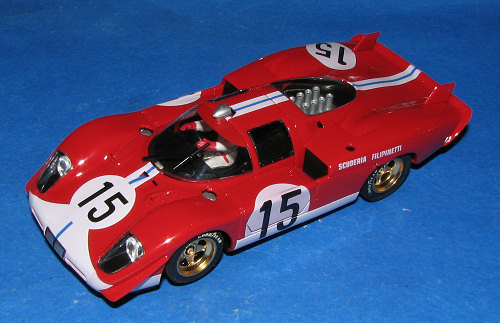 Before attaching the body, I
always add a drop of oil to each end of the motor shaft and to the various axle
bushings. That is step one even with a ready to run car as one does not want to
burn up a motor from it not being oiled. As with everything, one only uses a
drop as excess can ruin a motor as easily as not enough. the end result is
the very nice car you see to the left.
Before attaching the body, I
always add a drop of oil to each end of the motor shaft and to the various axle
bushings. That is step one even with a ready to run car as one does not want to
burn up a motor from it not being oiled. As with everything, one only uses a
drop as excess can ruin a motor as easily as not enough. the end result is
the very nice car you see to the left.
Of course, the kit tires, as nice as they are leave a lot to be desired in the traction area so were replaced with silicones at the first opportunity. These aftermarket tires generally cost about $5 a pair and are available from a number of on-line stores that specialize in slot cars. On my track, just changing to the better gripping silicones usually means a lap that is about a second quicker, less sliding (though the added grip usually means they tip over more), and fewer spin-outs.
Well, that is about it for this session. I hope you learned a bit and if you have any questions or wish to share your experiences or image of your track, I'd like to hear from you on the subject so please e-mail me at mmreaders@aol.com.
Scott